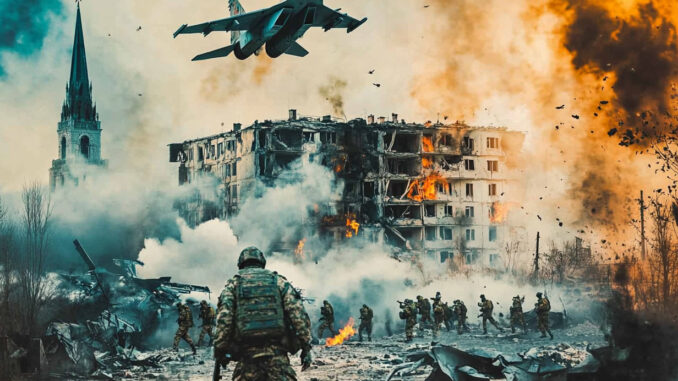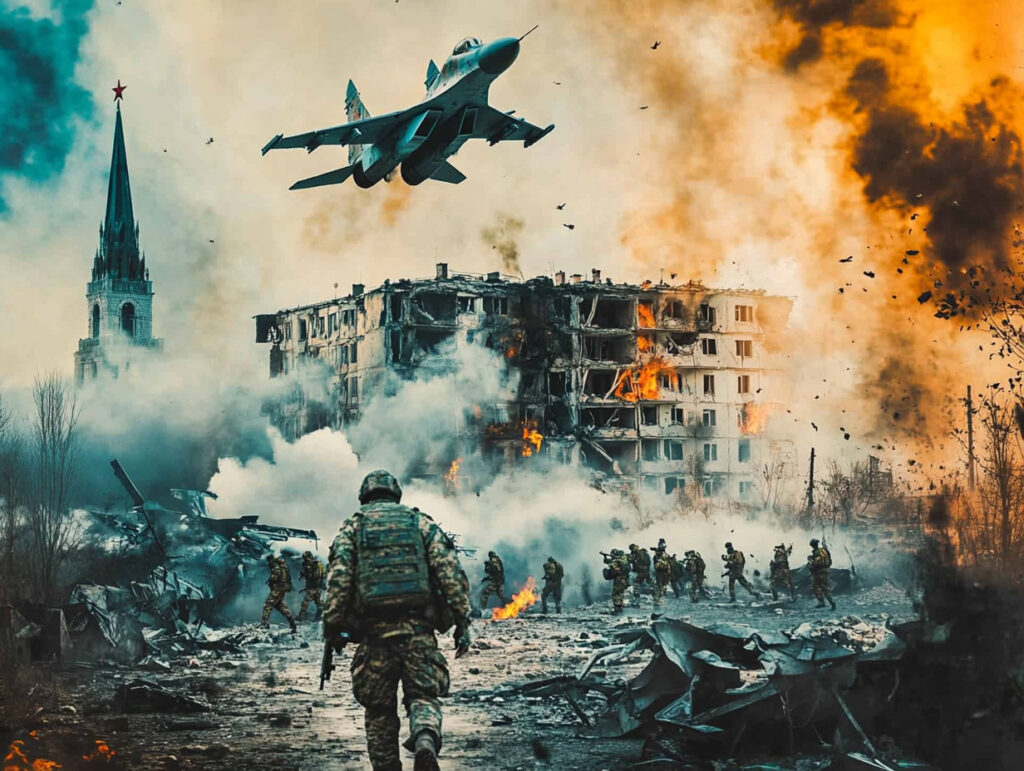
An in-depth analysis of the strategic reasons behind Russia’s invasion of Ukraine in 2022, Putin’s objectives, and the implications for the future of international security.
Russia’s invasion of Ukraine in 2022 is not a reaction to a perceived threat from NATO, but rather an attempt by Putin to reassert Russian dominance in Eastern Europe. This article explores in detail Putin’s underlying motivations, his flawed assessment of Western and Ukrainian forces, and the implications of this war for the global geopolitical balance.
1. Putin’s motivations: a quest for power rather than fear of NATO
Contrary to official Russian statements, the invasion of Ukraine in 2022 was not motivated by an imminent fear of NATO expansion. Rather, Vladimir Putin saw NATO as a weakened and divided alliance, incapable of responding effectively to Russian aggression. Since the fall of the Soviet Union, Putin has sought to re-establish Russia as a major world power, with firm control over its “near abroad”, notably Ukraine. In reality, Putin has always seen NATO not as a direct military threat, but as an ideological obstacle to his ambitions to restore Russian influence over the former Soviet republics. Russia did not mass military forces on its borders with NATO, which shows that Putin did not fear a NATO invasion, but rather sought to weaken the alliance from within by exacerbating internal divisions.
Russia’s positioning in Ukraine and Crimea since 2014 shows that Putin’s aim was to control Ukraine, not only in territorial terms, but also politically, by installing a pro-Russian government in Kiev. The 2022 invasion is thus the culmination of years of unsuccessful attempts to subject Ukraine to Russian will.
2. Putin’s errors of assessment: underestimating Ukraine and the West
Putin made a series of major errors of assessment which led to the failure of his initial objectives in Ukraine. Firstly, he seriously underestimated Ukraine’s capacity for resistance. When Crimea was annexed in 2014, the Ukrainian response had been relatively limited, leading Putin to believe that Ukraine would quickly submit to another military offensive. However, between 2014 and 2022, Ukraine strengthened its military capabilities and moved further towards integration with the West, a dynamic that was largely ignored by Moscow.
Secondly, Putin misjudged the West’s reaction. He expected NATO and the European Union to be divided and too weak to respond effectively to the invasion. This assessment was reinforced by events such as the United States’ precipitous withdrawal from Afghanistan in 2021, which Putin interpreted as a sign of American decline and disengagement on the international stage. However, the Western reaction has been far more unified and determined than expected, with tough economic sanctions against Russia and increased military support for Ukraine. This unexpected resistance has forced Putin to prolong a conflict that he initially thought he would win quickly.

3. Putin’s strategy: destabilising NATO and exploiting Western divisions
One of Putin’s strategic objectives in invading Ukraine was to destabilise NATO and exploit internal divisions in the West. Since the beginning of his reign, Putin has sought to weaken Western alliances by supporting Eurosceptic movements in Europe and establishing partnerships with countries such as Turkey and Hungary, which have often adopted more conciliatory positions towards Moscow. In 2014, Russia used the Nord Stream 2 pipeline project to create energy dependency in Europe, particularly Germany, in order to divide the positions of EU members in the face of Russian actions.
However, these efforts failed to break Western unity after the 2022 invasion. On the contrary, Russian aggression strengthened NATO’s cohesion, with membership processes accelerating for countries such as Finland and Sweden, which renounced their historic neutrality in the face of the Russian threat. Transatlantic solidarity has also been strengthened by the coordination of economic sanctions and military support for Ukraine. Putin has therefore failed to achieve his goal of fracturing the Western alliance, and his actions have in fact strengthened NATO against Russian aggression.
4. The geopolitical consequences of the invasion: a new balance of power in Europe
Russia’s invasion of Ukraine has had major geopolitical consequences, redefining the balance of power in Europe and beyond. One of the most direct consequences has been Russia’s growing isolation on the international stage. The economic sanctions imposed by Western countries have considerably weakened the Russian economy, with losses estimated at several hundred billion euros in terms of GDP and massive capital outflows. At the same time, Russia’s growing dependence on China for trade and technology has repositioned Moscow as a junior partner in this asymmetrical relationship.
In Europe, the invasion has led to a reassessment of defence and security policies, with increased military budgets in countries such as Germany, which has announced a special €100 billion fund to modernise its armed forces. The invasion also strengthened NATO’s role as the guarantor of European security, with an increased military presence on the alliance’s eastern flank to deter further Russian aggression.
Finally, the invasion led to an acceleration of the energy transition in Europe, with intensified efforts to reduce dependence on Russian hydrocarbons and diversify sources of supply, notably through the development of renewable energies and the import of liquefied natural gas (LNG) from the United States and other suppliers.
5. The future of the conflict: towards a resolution or a prolongation?
The question of how this conflict will end remains open, but it is unlikely that the war will end with a simple ceasefire or rapid negotiation. Putin’s objectives have not changed: he is still seeking to establish control over Ukraine and permanently weaken the West. Until these objectives are achieved, or Russia suffers a significant military defeat, the conflict could continue.
The West’s current strategy is to support Ukraine in the long term, providing it with the weapons it needs to defend its territory and maintaining economic pressure on Russia. This approach aims to exhaust Moscow’s capacity to continue the war while building Ukraine’s resilience. However, this strategy also carries risks, not least that Russia may turn to even more aggressive tactics, including the potential use of tactical nuclear weapons in the event of a major military defeat.
At the same time, Western support for Ukraine’s post-conflict reconstruction will be crucial in ensuring that the country can recover economically and politically, thereby limiting the chances of renewed hostilities in the future. Europe and the United States must therefore prepare for a long-term commitment to Ukraine, both for the current war and for the post-conflict period, in order to secure a stable and prosperous future for Ukraine and the whole of the European continent.
Russia’s invasion of Ukraine in 2022 is the result of a complex combination of geopolitical factors, miscalculations and Vladimir Putin’s expansionist ideology. By seeking to weaken NATO and re-establish Russian influence in Eastern Europe, Putin has unleashed a war that has not only destabilised the region but also reconfigured the global geopolitical order. Ukrainian resistance, supported by the West, has thwarted Moscow’s initial plans, but the conflict is far from resolved. For the future, the outcome of this conflict will depend on the West’s ability to maintain constant pressure on Russia while helping Ukraine to rebuild and defend itself against any future aggression. The end of the conflict will not come down to simple negotiation, but will require a clear defeat of Russia on the ground to guarantee lasting peace in Europe.
War Wings Daily is an independant magazine.